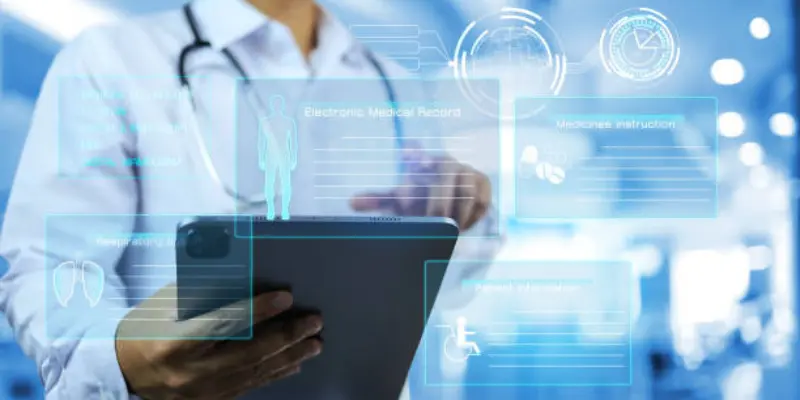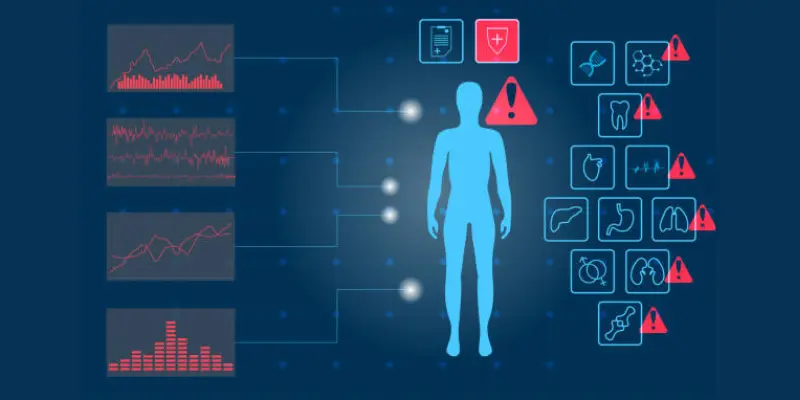What is the Role of AI in Medical Reports Reading
Published: 29 Apr 2025
Waiting days for test results can feel stressful. Sometimes, reports are hard to understand or full of medical words. That’s where the role of AI in medical reports reading becomes helpful. AI can speed up the process by explaining the results clearly and reducing long waiting times. Sounds good, right?
Studies show that AI can now read imaging reports as accurately as expert doctors. Hospitals are using AI tools to scan lab results, detect early signs of illness and help doctors make quick decisions.

What Are Medical Reports?
Medical reports are documents that tell what’s going on inside your body. These include test results, doctor notes, scan images and more. These reports help doctors understand your health better.
Let’s break it down with some simple examples:
- Lab Reports: Show things like blood sugar or cholesterol levels.
- Scan Reports: Include X-rays, MRIs or CT scans that help doctors see inside your body.
- Doctor Notes: Write-ups of what your doctor observed during checkups.
Doctors use these reports to find out if something is wrong, what treatment you need or how well you’re getting better.
What is AI in Medical Reports Reading?
AI in medical reports reading means using smart computer tools to understand test results, scan images and analyze doctor notes. These tools are trained to look at lots of health data and find important details just like an experienced human doctor does.
Here’s how AI helps:
- It reads lab reports and finds unusual numbers.
- It checks X-rays or MRIs for signs of illness.
- It highlights key points in long reports to save doctors time.
The goal? Help doctors make fast and correct decisions by giving them clear and useful information.
💡 Real-life example: Let’s say your CT scan report has small signs of a lung issue. AI can spot that tiny detail quickly even if it’s easy to miss and alert your doctor right away.
Also Read: Medical Imaging AI Companies in Healthcare
How AI Reads Medical Reports Carefully
AI makes reading medical reports easier and faster for doctors. Doctors are always busy and they don’t have time to spend hours on reading unnecessary things, AI highlights the most important parts of medical reports.
Here’s how it helps in different ways:
Scanning and Sorting Reports
AI can quickly go through tons of reports and organize them. It scans lab results, images and doctor notes, sorting them by importance or category.
How it helps:
- Saves Time: Doctors and staff don’t need to manually sort through reports. AI does this fast, leaving doctors with more time for patients.
- Organized Information: Instead of a pile of reports, everything is neatly sorted and easy to access.
Detecting Patterns and Errors
AI is great at spotting patterns and finding errors in reports. It looks for unusual results deeply, like signs of illness in lab reports or scans.
How it helps:
- Finds Problems Early: AI can spot early signs of diseases like cancer, before a doctor might notice them.
- Flags Missing Data: If something is missing or wrong in a report, AI will alert the doctor and prevent mistakes.
What does this mean? Will AI Take Over Medical Coding?
Example: Imagine an AI tool that scans pathology reports for signs of cancer. It flags critical reports for doctors to review and give them a head start in diagnosing and treating patients.

Translating Complex Data
Medical reports can be full of complicated words and numbers. AI simplifies these into easy to read summaries. This makes it easier for both doctors and patients to understand what’s going on.
How it helps:
- Clear Summaries: Doctors can quickly see the main points of a report.
- Faster Decisions: With simple summaries, doctors can make decisions more quickly and improve patient care.
Example: If a patient has a complex test result, AI can translate it into a simple summary, so the doctor doesn’t need to read through everything to understand the main issue.
Suggested Article: The Role of AI as Caregiver in Healthcare
Why AI Reading Reports Matters in Healthcare?
AI reading medical reports matters because it helps doctors make quicker and more accurate decisions. The faster doctors get clear information, the sooner they can start helping patients.
Here’s why it’s so important:
- Saves Time: AI can scan a report in seconds. That’s much faster than a human doctor, who might take minutes or longer to review it.
- Catches Problems Early: AI spots patterns in reports that might be easy to miss. Early detection means quicker treatment and better outcomes.
- Reduces Errors: AI can help find mistakes or missing information in reports, making healthcare more reliable.
- Helps in Remote Areas: AI tools can help doctors who might not have access to specialists, making healthcare more accessible.
Example: In a busy emergency room, doctors often have to review hundreds of reports. AI tools help by reading and organizing these reports so doctors can focus on what’s most important like diagnosing and treating patients quickly.
Challenges and Limitations of AI in Reading Medical Reports
While AI is a helpful tool in healthcare, it does have some challenges. AI causes problems in healthcare if not properly managed. Let’s look at some of the main ones:

AI Needs Lots of Data
AI learns by looking at tons of data. The more data it gets, the smarter it becomes. But sometimes, there is not enough data for AI to learn from. This can make it harder for AI to be accurate. If the data is limited or not diverse, AI might not perform well in certain situations or with some patients.
AI Can Make Mistakes
Even though AI is smart, it can still make mistakes. Sometimes it may misinterpret a report or miss a sign of illness. This is why AI should always be used with human doctors. If the AI tool is not trained well or lacks enough data, it might give wrong results. Doctors must double-check these results.
Dependence on Technology
If hospitals or doctors rely too much on AI, they may become dependent on technology. If the system breaks down it can slow down work or even cause delays. If the AI system faces a technical problem, doctors might have to go back to reading reports through old ways which will slow down the process.
AI Can’t Replace Human Judgment
AI is great at reading reports, but it cannot think like a human doctor. Doctors use their experience and knowledge to make decisions which is something AI can’t fully do. AI may be fast but it lacks the deep understanding and emotional intelligence that human doctors have.
Despite these challenges, AI still plays an important role in improving healthcare. The goal is to use it alongside human doctors to make healthcare smarter and more efficient.
Future of AI in Reading Medical Reports
The future of AI in reading medical reports looks very bright. As technology improves, AI will get even better at helping doctors understand and use medical data. Here’s what we can expect in the coming years:
Smarter AI Tools
AI tools are already learning to read reports more accurately. In the future, they will become even smarter. AI will be able to understand more complex reports and predict patient outcomes more effectively.
What this means:
- Better Accuracy: AI will help doctors catch even the smallest signs of illness, leading to faster treatments.
- Deeper Insights: AI will analyze reports from multiple sources (like scans and lab results) to give a clearer picture of a patient’s health.
AI for Personalized Medicine
In the future, AI will not just read medical reports but also help in creating personalized treatment plans. It will analyze a patient’s reports and medical history to suggest the best treatments for them.
What this means:
- Tailored Care: Doctors will have more information to offer treatments that are specific to the patient, improving outcomes.
- Precision: AI will help doctors to match treatments to a patient’s unique health needs.
Collaboration Between AI and Doctors
Instead of replacing doctors, AI will work alongside them to provide better healthcare. Doctors will rely on AI to quickly analyze reports, while they focus on making the final decisions and connecting with patients.
What this means:
- Teamwork: Doctors and AI will become a powerful team by the combination of human judgment with AI’s speed and accuracy.
- Improved Care: With AI’s help, doctors can focus more on patient care, knowing that the AI is supporting them with fast and accurate information.
Wider Access to AI Tools
As AI becomes more common, it will be available to more hospitals and clinics, even in remote areas. This means that patients everywhere will have access to better and faster medical care.
What this means:
- Global Access: AI will help to improve healthcare in underserved or rural areas where doctors may be limited.
- Better Outcomes for All: No matter where you live, AI will make sure you get quicker and more accurate diagnoses.
The future of AI in reading medical reports is all about working smarter, not harder. It is going to make healthcare faster, more accurate and more personalized for everyone.
Conclusion
AI is changing the way medical reports are read, making healthcare faster, more accurate and accessible to everyone. From helping doctors spot problems early to organizing data quickly, AI tools play a key role in improving patient care.
Here’s a quick recap of what we have learned:
- AI saves time by scanning and sorting reports.
- It detects patterns and errors, helping doctors find problems early.
- AI translates complex data into simple summaries and makes it easier for everyone to understand.
While there are some challenges like the need for more data and the possibility of errors, the future of AI in reading medical reports is bright. As technology improves, AI will keep getting better at supporting doctors and providing more personalized care.
In the end, AI is here to help not replace doctors and working together will make healthcare smarter and more efficient.
More Queries! Your Questions-Answered Below
Here frequently asked questions about AI in Medical Reports Reading:
Medical institutions using AI must follow strict privacy laws like HIPAA to protect your data. Most AI systems are designed with privacy features that encrypt or anonymize your information. Your consent is typically required before your data can be used for AI analysis.
Current AI systems can match expert-level accuracy in specific tasks like analyzing certain types of scans or lab results. However, accuracy varies depending on the quality of training data and the complexity of the medical condition. Human doctors still verify AI findings before making final diagnoses.
AI could potentially reduce healthcare costs by streamlining workflows and catching diseases earlier when they are less expensive to treat. Some studies suggest AI could save billions in healthcare spending through improved efficiency and reduced errors. However, the initial investment in AI technology might keep costs the same in the short term.
Many hospitals and clinics are already implementing AI tools for specific tasks like radiology or pathology report analysis. Widespread adoption will likely take 5-10 years as technology improves and regulatory frameworks develop. The transition will be gradual rather than sudden.
Yes, patients generally have the right to know how their medical information is being processed and can often opt out of AI analysis. Healthcare providers should inform you if AI is being used in your care. Your preferences should be respected as part of patient-centered care practices.
Medical schools are increasingly incorporating AI literacy into their curriculum for future doctors. Hospitals typically provide specialized training when implementing new AI systems. Continuing education programs help practicing clinicians stay updated on using AI tools effectively.
Consumer-facing AI tools are emerging that can help to explain medical terminology in simpler language. These tools can provide general information but are not sophisticated enough to replace professional medical advice. Always discuss important medical reports with your healthcare provider.
Healthcare providers maintain responsibility for final medical decisions, not the AI system. Multiple safety checks are typically in place including human verification of AI findings. If errors occur, the same medical malpractice frameworks that protect patients from human errors would apply.
Cloud-based AI services are making this technology increasingly accessible to smaller healthcare facilities. Government initiatives in many countries are working to ensure equitable access to medical AI. As costs decrease over time, adoption in smaller settings will become more feasible.
Patients may receive faster test results when AI helps with analysis. AI-generated plain-language summaries can make complex medical information more understandable. Some patient portals now include AI features that help to explain lab results and medical terms without requiring a call to your doctor.





